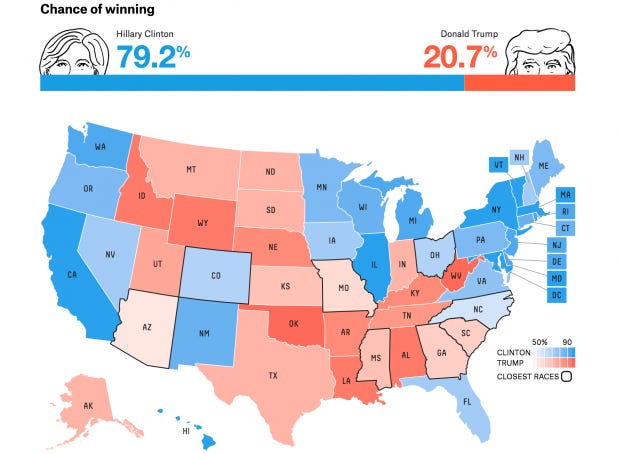538 launches first general election forecast 2016: Hillary 353 EVs to 183 Trump. 81% chance of win.

By floridageorge
Wednesday Jun 29, 2016 · 3:06 PM PDT
Read it and weep, Righty bitches!
538 just published its first general election projection for 2016.
538 Election Forecast
This is the starting point, folks. We are looking at 353 EVs for Hillary and 183 for Trump, with 270 EVs needed for the win. Also, odds of winning based on the EV projections of 80.6%. This can change up or down, nothing is in stone. But it is a good point from which to start the general election campaign in earnest. And, NO complacency allowed. GOTV efforts or registration drives should move on without regard to current polls or projections.


As you can see from the graph, 538 gives Florida to Hillary, also Arizona and North Carolina.

The odds were closer to 60% to 40% earlier in the month. Now it is a whopping 80.6% to 19.3%. Got to like that momentum and trajectory, with 130 days left to go.
All about the electoral votes:

The different scenarios, other than the topline, offered up in this computer model:

It’s worth noting that in 2008 Nate Silver got 49 states correct, and in 2012 his computer model got 50 states correct, the best prognosticator of them all.
Silver’s appearance on GMA announcing a slightly lower Hillary win percentage, likely because the series of Ballotpedia polls hadn’t been incorporated into the model yet.
By floridageorge
Wednesday Jun 29, 2016 · 3:06 PM PDT
Read it and weep, Righty bitches!
538 just published its first general election projection for 2016.
538 Election Forecast
This is the starting point, folks. We are looking at 353 EVs for Hillary and 183 for Trump, with 270 EVs needed for the win. Also, odds of winning based on the EV projections of 80.6%. This can change up or down, nothing is in stone. But it is a good point from which to start the general election campaign in earnest. And, NO complacency allowed. GOTV efforts or registration drives should move on without regard to current polls or projections.


As you can see from the graph, 538 gives Florida to Hillary, also Arizona and North Carolina.

The odds were closer to 60% to 40% earlier in the month. Now it is a whopping 80.6% to 19.3%. Got to like that momentum and trajectory, with 130 days left to go.
All about the electoral votes:

The different scenarios, other than the topline, offered up in this computer model:

It’s worth noting that in 2008 Nate Silver got 49 states correct, and in 2012 his computer model got 50 states correct, the best prognosticator of them all.
Silver’s appearance on GMA announcing a slightly lower Hillary win percentage, likely because the series of Ballotpedia polls hadn’t been incorporated into the model yet.







